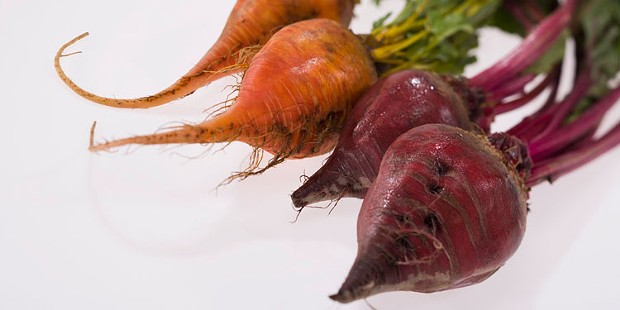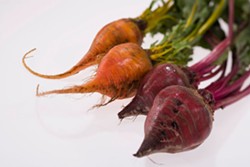[
{
"name": "Top Stories Video Pair",
"insertPoint": "7",
"component": "17087298",
"parentWrapperClass": "fdn-ads-inline-content-block",
"requiredCountToDisplay": "1"
}
]
The soil at my new place is marginal but well drained and it hasn't been gardened in a few years, so the weeds are pretty intense. A season's worth of root vegetables will condition the garden for spring planting.
It's a formula I've used many times: Dig up the lawn and plant potatoes, beets, turnips — anything that is big, fast growing and can compete with grass. Then mulch them up real good when they're half-grown and when you dig them up to harvest, voila! The result is fluffy, rich soil.
A Rainbow of Roots
Will all of these grow in your garden? Maybe. Because the West Coast is peppered in such a wide range of microclimates, it's hard to say. But one of the beautiful things about root vegetables is that they can be grown in any large container. Even if you don't have the ideal microclimate in your yard, you might be able to create the right conditions on a patio, in a greenhouse or on a windowsill in the kitchen. As such, I have included some veggies here that aren't as common in the U.S. as they are in South and Central America but, with a little trial and error, I think we can get a good crop on the North Coast.
Plant them now, it's the perfect time. And in most cases, plant them again in the spring. And again in the summer.
Beets: Direct sow, then, when they're about 2 inches high, take the time to carefully thin the clusters of baby beets to 6 or 8 inches apart. They'll get yuge!
Burdock: Bumblebees love it! Harvest first-year roots from plants that haven't sent up a flower stalk yet. Use for tea or peel, chop and fry in oil. Tasty!
Canna: Not commonly eaten in the states but in South America that fabulous red-flowered canna is food. So easy to grow, so completely gorgeous. Look specifically for Canna edulis, since the other species aren't edible.
Carrots: Carrots come in a full spectrum of colors and, like all foods, the nutritional value varies with the color. For example, purple carrots are high in anthocyanin, an amino acid that helps the body process food and combat disease.
Celeriac: I can't stand celery. I don't grow it and I don't eat it. But celeriac? I love it! Some would say the flavor is the same but I just love that crunchy-creamy texture of baked celeriac. And the knobby, odd-looking plants are a great conversation piece in the garden.
Garlic: Always plant garlic. (See my earlier article "Growing Gorgeous Garlic," Sept. 17, 2015.)
Ginger: I got some really nice ginger from the store. It was on my windowsill for a couple of weeks and it started to sprout. So I planted it in big pots on the patio and now I have huge flowering plants. So easy.
Jicama: Did you know jicama is a bean? Well, technically it's the root of a bean. The Lima-like pods are also edible but the good stuff is under the soil in that juicy, sweet and crunchy root. Try it sliced into fingers and dipped in hot sauce.
Oca: Oca has been a staple of Andean diets for centuries. Some years ago, farmers on the West Coast discovered that oca grows well around here and in more colors than you can fit in one hand. And they're spicy! Flavors vary as much as the colors do.
Onions: I pick up bags of onion sets when they're on sale at the nursery and plant them compulsively on corners and borders.
Parsnips: Some people love 'em, some people hate 'em, but everyone should wear gloves and long sleeves when harvesting because fresh parsnips can cause a terrible, blistering skin rash.
Potatoes: Potatoes come in every color you can imagine. My favorites are the yellow fingerlings that taste like butter when they're new.
Radishes: Radishes are easy, fast and so much fun to grow. Top of the list for children's gardens.
Rutabaga: Native to Sweden, this root is similar to a turnip but bigger, more gnarly and hardy through ridiculously cold temperatures.
Salsify: The root tastes like oysters. The flowers are huge, purple and fantastic. Need I say more?
Sunchokes: Once you've established a patch of sunchokes, (aka Jerusalem artichokes) you'll always have plenty on hand because they sprout readily from the smallest portion of a tuber left in the ground. They are reasonably drought tolerant and make 10-foot-high flowers that look like sunflowers. In fact, they're closely related, but this species makes edible tubers.
Sweet Potatoes: Did you know they're in the morning glory family? The flowers are beautiful and sweet potatoes might be easier to grow than you realize. Look for "slips," tiny rooted plantlets that you can order in the late spring.
Tapioca/Yuca/Taro/Cassava: Yep, they are all the same thing! I had no idea until doing research for this article. I've eaten this plant in so many different ways, by so many names, in so many different countries that I assumed they were all different. Manihot esculenta is one of the most diverse food plants on the planet. It grows easily in most West Coast microclimates but learn to prepare it correctly because improperly processed roots are poisonous.
Turmeric: All the rage with super-food enthusiasts everywhere, turmeric is actually pretty easy to grow as a houseplant in our climate.
Turnips: Not a fan? I wasn't either until I grew my own. Harvest them young for a milder flavor. Grate them and make vegetable fritters. Mmhmm!
Ulloco: Obscure but easy to grow, this Andean tuber tastes a lot like jicama. Ulloco is related to Malabar spinach, if that means anything to you.
Yacon: If you haven't tried this looks-like-a-yam-but-tastes-like-grape-cider crunchy purple root from the Andes that has recently gained major popularity in American markets, you're missing out. Yacon is nutritious, delicious and fairly easy to grow as long as the gophers don't get to those yummy tubers before you do.
Yams: Not the same as sweet potatoes and not so easy to grow. Yams are actually more closely related to lilies and grass than sweet potatoes and aren't easily grown anywhere on the West Coast.
Pro Tips
Mulch: Most root vegetables like a moist, thick mulch at least twice during the growing season.
Harvest: It's fun to dig up a fresh crop of tasty tubers! But resist the urge to toss them around. Bruises become rotten spots in storage and you'll get a much longer shelf life with undamaged produce.
Storage: Cut off all leaves and gently clean roots with a damp towel and store in a cool, dark, dry place on cardboard (not plastic) trays. Try to place them so that they don't touch each other. If you stack them, put a paper bag or sheet of cardboard between layers, staying mindful of air circulation. Follow these basic steps and you can store potatoes, yams, garlic and most other roots for several months without refrigeration.
Make veggie chips: Sliced root vegetables, dried in a food dehydrator, are the best!
Heather Jo Flores wrote Food Not Lawns, How to Turn Your Yard into a Garden and Your Neighborhood into a Community. Read more of her writing at www.patreon.com/heatherjoflores.
more from the author
-
Hashtag, Bumper Crop
Veggies to plant now for fall and winter
- Aug 17, 2017
-
Plotting Out Your Garden: Part 2
- Apr 6, 2017
-
Think Outside the Garden Box
- Mar 9, 2017
- More »


































